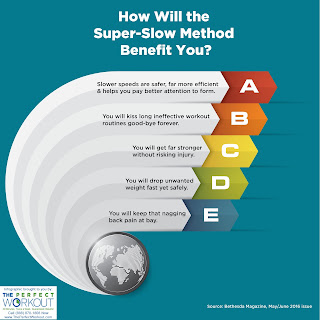We would like to thank the Washington Post for choosing to feature us in an amazing article that helps spread the message about Slow Motion Strength Training and the amazing results associated with this scientifically proven method.
Here's the original article:
Slow-motion strength training is hard — and fast
By Rachel Pomerance Berl
One of the newest fitness studios in the D.C. area feels less like a gym and more like a physical therapist’s office. The Perfect Workout, which opened in August in Bethesda and Falls Church, offers clients personal training in a quiet, no-frills space filled with Nautilus equipment and framed testimonials (many from clients of an advanced age). It promises a complete workout in just two short sessions per week.
The drill: A high-intensity, low-impact program known as
slow-motion strength training, in which gradually lifting and releasing weights without the aid of rest or momentum brings muscles to exhaustion. It’s extremely difficult. It’s also only 20 minutes.
Though The Perfect Workout, a California-based outfit founded in 1999, is new to the East Coast, the concept isn’t.
The Perfect Workout and other slow-motion training companies such as SuperSlow Zone, which has a location in Sterling, Va., and InForm Fitness, which has a studio in Leesburg, Va., cite principles outlined just over 30 years ago by fitness professional Ken Hutchins. In slowing down movements to safely train women with osteoporosis, Hutchins concluded that the technique builds muscle more effectively than conventional weight training, although others have contested this assertion.
The effectiveness of slow-motion strength training depends on the individual, according to Lee Jordan, a Florida trainer and spokesman for the American Council on Exercise, but it offers a broad range of people a safe and viable program.
Like high-intensity interval training, Jordan says, it seeks to remove the top barrier to exercise: time. But unlike high-intensity interval training (“by its very nature, it’s extreme,” he says), slow-motion strength training is accessible to anyone.
While advocates of slow-motion strength training claim it satisfies the need for cardiovascular activity, Jordan and other fitness experts argue that people require a mix of aerobic activity and strength training.
Still, the key to an exercise routine is sticking to that routine. And some clients say this program works.
“People love to hate this place,” says Nicole Gustavson, owner of Leesburg’s InForm Fitness. “But they keep coming back because they get results.”
At SuperSlow Zone in Sterling, Jannet Anmahian, 83, makes a show of exhaustion from her weight machine — sticking out her tongue and clasping her hands together in a sarcastic plea for help.
“I always complain,” she says, calling it “part of the game.”
Anmahian adds that “there are no words” to describe the value of this program, which she’s followed for more than 30 years and has no intention of stopping.
Mark Ello, 51, of Leesburg, began training at SuperSlow Zone in 2002 to shape up for his 20-year high school reunion. Since then, he reports better body composition plus lower blood sugar and cholesterol.
“It’s like a Chevy,” he says of the workout. “It’s not sexy, but it gets you from point A to point B.”
Click Here for the original Washington post article:
http://goo.gl/9PSXIN



